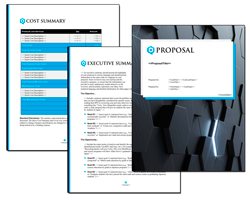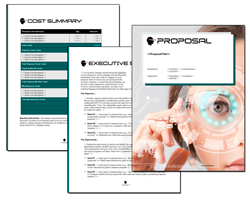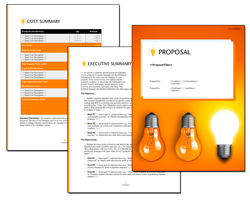
Mastering How to Write an AI Project Proposal
This article will get you started writing your AI project proposal, ensuring you cover the critical components that convey your project's value, feasibility, and impact to stakeholders or funders clearly and convincingly. Learn best practices for writing AI project proposals that stand out from the competition and have a real impact.
Key Takeaways
- An AI project proposal should clearly articulate the problem, outline the objectives and scope, detail the use of AI technologies, highlight its unique value propositions, and present expected outcomes. Expected outcomes are the results or benefits that you anticipate from your project. These could include improved efficiency, cost savings, increased revenue, or enhanced customer satisfaction. Setting realistic and measurable outcomes is essential to demonstrate your project's value.
- The proposal must clarify the budget, including a breakdown of costs and payment terms, and detail the proposed solution's data collection, model development, and expected impact.
- Critical stages in the proposal creation process include drafting and revising the document, ensuring clear and concise communication of complex ideas, and a final review for consistency and completeness before submission. Focusing on communication can ensure your proposal is clearly understood.
Understanding AI Project Proposals

An AI project proposal is a structured document that outlines an AI initiative in detail. Its importance lies in its ability to communicate the value and feasibility of an AI project to potential funders or stakeholders. Whether it's responding to government Requests for Proposals (RFPs), pitching to private investors, or proposing an internal company project, AI project proposals are an integral part of the business development plan.
Understanding AI project proposals involves knowing their purpose, structure, and components. The proposal should include the following:
- Clearly articulate the problem being addressed
- Outline the AI technologies that will be used or created
- Describe the project's unique value propositions
- Lay out the objectives, scope, and expected outcomes
- Present realistic costs, budgets, and schedules
- Finish with recommendations and calls to action
Unique Challenges of AI Software Projects

AI software projects are inherently different from traditional software projects due to their unpredictability, legal and ethical complexities, public scrutiny, and continuous need for monitoring and updating. Addressing these challenges requires an approach that combines technical expertise with legal, moral, and public relations strategies to ensure the development of reliable and responsible AI systems.
When writing your proposal, add chapters to cover these topics. Otherwise, the basic structure and flow of the proposal will be the same as any other software development project proposal. The Proposal Kit chapter template library includes topics to cover these issues, which can be included in your proposal.
Dealing with Unexpected AI Output
Due to the nature of the algorithms, AI software projects often yield unpredictable outcomes. Unlike traditional software, where outputs are more deterministic and predictable based on given inputs, AI systems can produce varied results based on the training data and the inherent randomness in their learning processes. This unpredictability requires rigorous testing and validation to ensure the AI behaves as expected under various conditions.
Managing Public Perception
AI projects are under intense public scrutiny, particularly when they produce undesirable or harmful results. A single instance of biased or incorrect output can significantly damage the reputation of the AI software and its creators. A robust strategy for managing public perception is essential, which includes transparency about how the AI works, how it was trained, and what measures are in place to mitigate errors. Clear communication and timely responses to issues are crucial in maintaining trust.
Legal and Ethical Considerations
The training data used in AI models raises legal and ethical questions. Ensuring that data is sourced ethically and complies with privacy laws is crucial. This includes obtaining proper consent for data usage, anonymizing personal data, and avoiding biased datasets that could lead to unfair or discriminatory outcomes. Legal considerations also extend to the intellectual property of the training data and the AI models themselves.
Liability Issues
AI systems, especially those dealing with YMYL (Your Money or Your Life) topics, such as healthcare, finance, and legal advice, carry substantial liability risks. Incorrect or biased recommendations can have serious consequences, potentially causing users harm or financial loss. Establishing clear guidelines on AI's usage, including disclaimers about its limitations and the need for human oversight, can help mitigate these risks. Additionally, thorough documentation and regular audits of the AI's performance are necessary to ensure accountability and traceability.
Continuous Monitoring and Updating
Unlike traditional software that might need periodic updates, AI systems require continuous monitoring and updating. This is due to the dynamic nature of AI models, which can change and degrade over time as new data and scenarios emerge. Implementing a robust monitoring system to track the AI's performance and retraining the model with new data to maintain accuracy and relevance is essential for the longevity and reliability of AI software.
Interdisciplinary Collaboration

AI projects often require collaboration across various disciplines, including data science, software engineering, ethics, law, and domain-specific expertise. Successful AI development requires integrating insights from these diverse fields to address the multifaceted challenges posed by AI technology. Building a cross-functional team that can tackle these issues from multiple angles is crucial for developing effective and responsible AI solutions.
AI Project Proposal Use Cases
AI-powered systems are rapidly proliferating into every industry, transforming how businesses operate and compete. As AI technology advances, its integration across all sectors is inevitable. Here are just some examples of where AI is now being used:
- AI-Powered Customer Service Chatbots
- Predictive Maintenance Systems
- Fraud Detection Systems
- Personalized Marketing Campaigns
- Automated Financial Forecasting Tools
- Healthcare Diagnostic Tools
- Autonomous Vehicles
- Natural Language Processing (NLP) Applications
- Smart Home Automation Systems
- AI-Enhanced Cybersecurity Solutions
- AI in Education
- AI for Supply Chain Optimization
- Facial Recognition Systems
- AI for Environmental Monitoring
- AI in Retail Analytics
- Voice-Activated Assistants
- AI in Sports Analytics
- AI-Driven Multimodal Content Creation
- AI for Legal Research
- AI in Urban Planning
Understanding the use case of your proposal is crucial as it provides context and relevance to your proposed project.
Defining the Proposed Project
Defining the proposed project is the first step in creating a successful proposal. An AI project proposal should be a structured document outlining goals, methodologies, and the anticipated impact of an AI initiative. It should clearly articulate the problem the project addresses and enumerate the AI technologies that will be used or created.
Furthermore, a project proposal must include the following:
- A description of the project's unique value propositions
- An outline of the project scope, including the timeline and resources required for successful implementation
- A detailed project plan for data collection, model development, and evaluation metrics
- Identification of potential risks and proposed mitigation strategies
These components are essential for a comprehensive project proposal; using a proposal template can help ensure you include them all.
Identifying Stakeholders and Decision Makers

Understanding the interests and concerns of stakeholders and decision-makers is crucial; it's a vital part of the proposal process. Relevant team members and stakeholders must be involved to ensure collaborative progress and accountability throughout the AI project. Knowing the audience is an essential step in writing a technical proposal; it's a way to show them that their needs and goals are at the heart of your solution.
Collaboration tools integrated into the proposal process can foster effective communication and collaboration among team members.
Creating a Winning Executive Summary
The executive summary is an essential part of your AI project proposal. It encapsulates all the critical information of the main document, providing a concise overview of the key elements. The beginning of the executive summary should set the stage by stating the company's mission and vision to reflect the project's overarching goals. The executive summary should also briefly describe the problem, the proposed solution, and the expected outcomes. This summary should be engaging and persuasive, as it is often the first and sometimes the only part of the proposal that potential funders or stakeholders will read before they pass it off to others to process the details.
Creating a winning executive summary requires the following:
- Using concise, engaging language
- Considering the audience's background to ensure clarity and connection
- Incorporating persuasive language that resonates with the readers' emotions, logic, and values
These strategies can significantly influence the recipients' response to the proposal.
It's important to remember that the executive summary typically ranges from 1 to 2 pages. It briefly presents the main points without getting into excessive detail. Concluding the executive summary with a clear overview of the essential findings and a call to action outlining the next steps is vital for guiding the reader toward the proposal's intended outcome.
Outlining the Project Scope

A well-defined project scope is crucial in a project proposal as it sets clear boundaries for managing goals and expectations. The project scope includes specifying the assets to be delivered at the project's conclusion, such as AI models, software, or reports, and providing a detailed account of the project's rules, conditions, and expected deliverables. This helps prevent scope creep and ensures the project stays on track.
Let's look further into establishing clear objectives and implementing a realistic project timeline.
Establishing Clear Objectives
The objectives of your AI project must align with the organization's vision, comply with regulatory standards, and support long-term company initiatives. Objectives should demonstrate how the AI project will deliver tangible business value, considering revenue growth or cost reduction, and evaluate industry trends for lasting competitiveness.
Using the SMART criteria (Specific, Measurable, Achievable, Relevant, and Time-bound) for objectives enables the tracking of project success using quantifiable metrics.
Milestones and Timeline
A roadmap highlighting key dates and milestones is essential to track the project's progress. The implementation plan should clearly outline the phases, schedule, and time frames necessary for the project's completion, ensuring service delivery by the proposed milestones.
Project objectives and milestones may require adjustments as the project evolves or in response to changes in external circumstances.
Detailing the Proposed Solution

Detailing the proposed solution is a critical element of the AI project proposal. This involves creating a detailed plan for data collection, which is essential for training and refining AI models to ensure they can fulfill specific client or project requirements.
Now, let's explore the proposed solution's technical approach and the expected impact and benefits.
Technical Approach
The technical approach should consider the following:
- The appropriate AI tools to be used
- How they will be integrated into the project
- Addressing the transparency and explainability of the AI systems being used
When describing the AI research and AI tools in the proposal, it is essential to:
- Lay out any restrictions on the tools' usage
- Define monitoring strategies for tool use
- Establish approval processes for tools chosen by the project team
- Responding to unexpected results
Expected Impact and Benefits
Adopting artificial intelligence results in improved decision-making, accuracy, and efficiency, which stimulates innovation and growth and fosters job and skill development. In educational environments, the use of AI tools can enhance the student experience through dedicated training, adequate support, and adjustments to existing structures. Different use cases and industries will have unique impacts and benefits.
Financials: Budget and Pricing
Understanding the financial costs of AI projects is crucial. Creating a comprehensive budget for AI projects involves considering the following:
- Development costs
- Data-related expenses (training and API costs)
- Hardware expenses
- Infrastructure investments
- Operational expenditures
- Human resource costs
Including a clear cost breakdown and payment terms in a technical proposal is crucial to ensuring transparency regarding project expenses and payment expectations.
Cost Estimation

Estimating the cost of AI services includes accounting for computational resources, specialized software, personnel, data acquisition, and other necessary expenses for project execution. A comprehensive cost-benefit analysis for AI projects entails defining the project scope, estimating costs, projecting benefits, assessing risks, and determining a timeline for expected returns.
Visualizing Success: Proposal Presentation
Creating visually appealing and effective proposal presentations is critical to capturing your audience's attention. A clean and uniform layout, cohesive color scheme, and readable fonts can enhance design consistency in a business presentation.
The proposal's presentation at a meeting should encompass its main points, including the research topic, aims, objectives, and methodology, to facilitate quick comprehension of complex ideas.
Writing Style and Clarity
It is crucial to maintain a consistent writing style and clarity throughout your AI project proposal. Simple language devoid of jargon and technical terms makes the proposal accessible to all audience members, regardless of their technical background.
Engagement with readers through concise, compelling proposal writing that employs an active voice and a personal, friendly tone can enhance the persuasiveness of the proposal.
Visually Appealing Documents
A consistent and appealing format with legible fonts, headings, bullet points, and white space improves the proposal's readability and reflects the brand positively. Enhancing the layout with branding elements such as logos and a consistent color palette creates a visually appealing and professional-looking proposal.
Visual elements such as flowcharts, diagrams, graphs, and charts can make the proposal more engaging and help clarify complex information.
Here are some related samples included in every downloadable Proposal Pack
Here are some related downloadable templates
- AI Based Content Creation Proposal Template
- AI Based Fitness Coaching Platforms Proposal Template
- AI For Supply Chain Optimization Proposal Template
- AI Personal Assistants for Productivity Proposal Template
- AI Powered Educational Tools Proposal Template
- AI Proposal Template
- Artificial Intelligence Project Funding Proposal
- Artificial Intelligence Proposal Template
- Chatbot Development Proposal Template
- Chatbot Services Proposal Template
- Home Assistant Artificial Intelligence Project Proposal
- Machine Learning Research Proposal Template
- AI Based Matchmaking App Proposal Template
- AI Content Creation For Web Site SEO Proposal Template
- AI Content Moderation Proposal Template
- AI Driven Health Diagnostics Proposal Template
- AI Driven Social Media Analytics Proposal Template
- AI For Energy Management Proposal Template
- AI For Environmental Protection Proposal Template
- AI For Financial Fraud Detection Proposal Template
- AI For Mental Health Support Proposal Template
- AI In Agriculture Proposal Template
- AI In Autonomous Vehicles Proposal Template
- AI In Entertainment Personal Recommendations Proposal Template
- AI In Fashion For Trend Forecasting Proposal Template
- AI In Gaming Proposal Template
- AI In Legal Document Analysis Proposal Template
- AI In Manufacturing For Predictive Maintenance Proposal Template
- AI In Retail Customer Experience Proposal Template
- AI Personal Assistants For Productivity Proposal Template
- AI Relationships Proposal Template
- AI Website Builders Proposal Template
- FinTech Pilot Project Implementation Proposal Template
- FinTech Research and Development Funding Proposal Template
- Marketing Apps Proposal Template
The Proposal Creation Process
The process of creating an AI project proposal involves several phases:
- Drafting the proposal
- Revising and refining the proposal
- Reviewing the proposal for accuracy and completeness
- Submitting the proposal
Each phase requires careful attention to detail and adherence to quality standards.
Let's look further into each of these stages.
Drafting and Revision
Drafting and revising proposals are not one-off exercises but recurring processes that ensure the coverage of all critical components. The drafting process includes the following steps:
- Design a project proposal outline
- Write the introduction and main sections
- Refine the proposal through multiple iterations to enhance clarity and cover all critical aspects
This iterative process is crucial to creating a comprehensive and effective business proposal.
Generating your proposal using AI proposal writers may be tempting, but they should be used cautiously. Your proposal shouldn't read like it was written by an AI, even if you are proposing an AI project. Use AI tools as assistants to speed up your writing, create outlines, and organize your material. Use human editors to ensure everything is correct and impart your view and information to the proposal.
Final Review and Submission
The final review of the proposal should ensure that:
- The document is consistent and accurate
- It is free of spelling and grammatical errors
- All formal requirements have been met, including RFP requirements, necessary compliance, and regulatory approvals.
Before submitting a proposal, obtaining all necessary internal approvals is crucial to ensure that administrative, policy, financial considerations, and departmental consents are addressed. In the final review, ensuring that the proposal aligns with the prospective customer's criteria and expectations is crucial.
 Proposal Kit Professional provides the most content, including legal contracts and a free design theme pack. Plus, advanced software features include custom branding and customizable quoting databases.
Proposal Kit Professional provides the most content, including legal contracts and a free design theme pack. Plus, advanced software features include custom branding and customizable quoting databases. Proposal Pack for Any Business covers this type of proposal and includes samples. There are also some commonly used specialty design themes available:
Proposal Pack for Any Business covers this type of proposal and includes samples. There are also some commonly used specialty design themes available:Photo Design Proposal Packs
 Proposal Pack Artsy #12
Proposal Pack Artsy #12 Proposal Pack Business #23
Proposal Pack Business #23 Proposal Pack Computers #5
Proposal Pack Computers #5 Proposal Pack Concepts #15
Proposal Pack Concepts #15 Proposal Pack Concepts #16
Proposal Pack Concepts #16 Proposal Pack Contemporary #19
Proposal Pack Contemporary #19 Proposal Pack Contemporary #21
Proposal Pack Contemporary #21 Proposal Pack Contemporary #22
Proposal Pack Contemporary #22 Proposal Pack Robotics #1
Proposal Pack Robotics #1 Proposal Pack Robotics #2
Proposal Pack Robotics #2 Proposal Pack Software #1
Proposal Pack Software #1 Proposal Pack Software #2
Proposal Pack Software #2
Next Steps After Proposal Submission
After submitting a proposal, following up with the prospective client is essential. Here are some important steps to take:
- Give a presentation summarizing the proposal.
- Be prepared for questions and anticipate possible inquiries.
- Take detailed notes during the proposal discussion.
- Write a comprehensive report on the required changes and decisions.
- Share the report with all relevant parties.
Taking these steps will help ensure a successful follow-up after the proposal meeting.
Follow-up communications should add value and create urgency by sharing relevant information, case studies, and testimonials. Understand the prospect's concerns and offer factual responses and alternative solutions to handle objections or rejections.
When receiving a positive response, close the deal swiftly by confirming document requirements, terms, and any clarifications needed.
Summary
In conclusion, creating a successful AI project proposal involves a structured process that requires careful planning, detailed outlining, clear communication, and thorough review. With an executive summary, clear objectives, a detailed project scope, and a comprehensive solution, your AI project proposal can communicate the value and feasibility of your project. Every stage of the proposal creation process is crucial, from defining the project to submitting the proposal and following up with the client.
Frequently Asked Questions
What is an AI project proposal?
An AI project proposal is a detailed document presenting an AI initiative's value and feasibility to potential funders or stakeholders. It outlines the project's objectives, methods, and expected outcomes.
What should an AI project proposal include?
Your AI project proposal should include an executive summary, project objectives, project scope, proposed solution, budget, and payment terms to ensure a comprehensive and compelling proposal.
How can I make my proposal visually appealing?
To make your proposal visually appealing, apply a consistent and attractive format with legible fonts, headings, bullet points, and white space. Enhancing the layout with branding elements such as logos and a consistent color palette can create a visually appealing and professional-looking proposal.
How should I handle objections or rejections after the proposal submission?
When handling objections or rejections after proposal submission, it's essential to understand the prospect's concerns and offer factual responses and alternative solutions that effectively address them.
What are the next steps after submitting the proposal?
After submitting the proposal, it's essential to follow up with the prospective client, anticipate questions, and take detailed notes during the discussion to prepare a comprehensive report on any required changes.



 Cart
Cart
 Are you just looking for a template, sample, or software for your AI project proposals? Click these links to skip down the page and get right to it.
Are you just looking for a template, sample, or software for your AI project proposals? Click these links to skip down the page and get right to it.

 Facebook
Facebook YouTube
YouTube X
X Search Site
Search Site